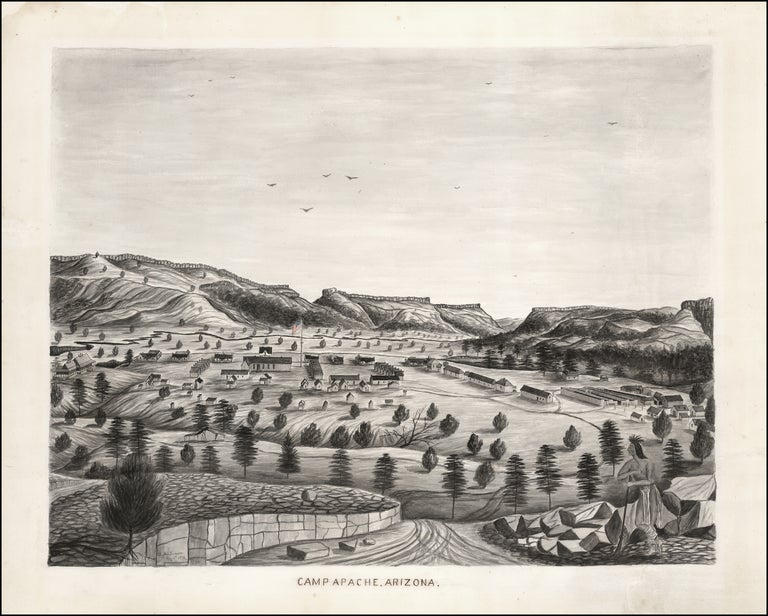
click here to zoom
Camp Apache, Arizona.
Gray watercolor with red, white and blue highlights on heavy wove paper, image area 16 ¼ x 21 inches, sheet size 20 x 25 inches.. A few minor spots & some neatly-mended edge tears, of which two extend into image, else excellent. An important, wonderfully detailed, signed and dated watercolor view of arguably the most storied western American fort, here called Camp Apache, later becoming Fort Apache. The fort was located near present-day Whiteriver in the central eastern part of Arizona. It was at the flashpoint of the decades-long Apache Wars and was the setting for several films made during the golden age of the American Western. When this view was painted in 1876, the war was still very much at its height. The view depicts Camp Apache as seen from along the road approaching from the west, against a striking backdrop of mesas and canyons. The East Fork of the White River is visible just to the left (north), and in the foreground the approach road passes through gently rolling terrain. The outpost itself is shown in great detail, with dozens of buildings from lowly outhouses to stables, enlisted barracks, the commander’s residence and the headquarters. The watercolor reveals that Fort Apache was not a fort per se but rather a sizable military base, befitting its pivotal role in the Indian wars. Flying in the very center is the stars and stripes, picked out in red, white and blue in a lovely contrast with the otherwise gray wash used by the artist. At far lower right a native American warrior stands beside the road, wearing only a loincloth, leggings and a feathered headdress, and is leaning on his rifle. In 1871 General George Crook, the fort's commander, enrolled 50 White Apache men to work as scouts; the Indian figure in watercolor is likely one of these. The watercolor is signed and dated at lower left “G. Anderson. Aug. 5th 1876.” Anderson was most likely a soldier serving at Camp Apache, but thus far we have been unable to determine his identity. Camp Apache and the Apache Wars The future Camp Apache was established as Camp Ord in 1870 on the south bank of the east fork of the White River, Arizona, some 150 miles east of Phoenix as the crow flies. Its construction was overseen by Brevet Colonel John Green of the U.S. 1st Cavalry, who explained the location as follows: “I have selected a site for a military post on the White Mountain River which is the finest I ever saw. The climate is delicious, and said by the Indians to be perfectly healthy, free from all malaria. Excellently well wooded and watered. It seems as though this one corner of Arizona were almost its garden spot, the beauty of its scenery, the fertility of its soil and facilities for irrigation are not surpassed by any place that ever came under my observation. Building material of fine pine timber is available within eight miles of this site. There is also plenty of limestone within a reasonable distance. “This post would be of the greatest advantage for the following reasons: It would compel the White Mountain Indians to live on their reservation or be driven from their beautiful country which they almost worship. It would stop their traffic in corn with the hostile tribes, they could not plant an acre of ground without our permission as we know every spot of it. “It would make a good scouting post, being adjacent to hostile bands on either side. Also a good supply depot for Scouting expeditions from other posts, and in fact, I believe, would do more to end the Apache War than anything else.” (from the web site of the Fort Apache Heritage Foundation) Camp Apache, upgraded to Fort Apache in 1879, was an important base in the long “Apache Wars” fought during the second half of the 19th century and even into the 20th. With the invaluable assistance of the aforementioned volunteer scouts from the largely friendly White Mountain and Cibecue bands of Apache, highly-mobile cavalry units operating out of the outpost played an important role in subduing the hostile Chiricahua band, led most famously by Geronimo. Fort Apache was finally closed and transferred to the Interior Department in 1922; some of its buildings still stand and are in use today. Provenance Eberstadt & Sons; Kennedy Galleries; Doyle Auctions sale 2006AM01 (May 2, 2006); Donald Heald and William Reese Company.
Sold

